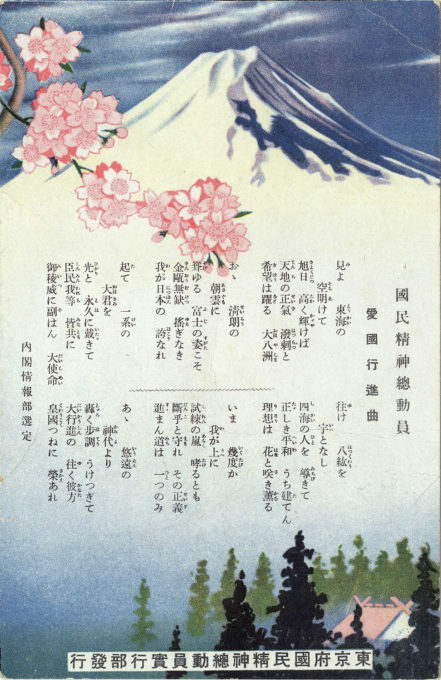
“Patriotic March”, lyrics, c. 1937. As part of the government’s National Spirit Mobilization, “Patriotic March” [“Aikoku koshinkyoku”] was released simultaneously by all the major recording companies in Japan in December, 1937 soon after the outbreak of open war between Japan and China.
See also:
Kimigayo (National Anthem) Commemorative Postcard, c. 1910
Attack on Pearl Harbor propaganda postcard, c. 1942.
National Spiritual Mobilization Movement propaganda postcard, c. 1940.
“On December 9, 1941, the day after [Japan Standard Time] Japan’s attack on Pearl Harbor, the Osaka Mainichi and Tokyo Nichinichi newspapers announced that they were hosting a public song contest for the best war effort, inviting their readers to submit the lyrics for a song entitled ‘The Song of the Final Battle in Greater East Asia’ (‘Daitoa kessen no uta’). The song was released by both Columbia and Victor in March 1942, featuring some of the star singers from each company.
“… [T]he template for a song like this was created as early as December 1937, when ‘Patriotic March’ (‘Aikoku koshinkyoku’) was released simultaneously by almost all major recording companies, a few months after the outbreak of Japan’s war with the Chinese nationalist forces. Among all the songs that were produced in wartime Japan, ‘Patriotic March’ was the one the state was likely most heavily involved in terms of its production and promotion.
“As with ‘The Song of the Final Battle in Greater East Asia’, the Cabinet Information Section (CIS), the predecessor of the Cabinet Information Bureau, hosted a public contest for the song’s lyrics, promising a remarkable sum of 1,000 yen, roughly a year’s income for an average white-collar household, to the winner of the contest; perhaps because of this, the context attracted nearly sixty-thousand entries. Judges for the contest included luminaries of Japan’s literary world, including Kitahara Hakushu and Shimazaki Toson, who also edited the contest winner’s work.
“… [T]he music for ‘Patriotic March’ was thoroughly within the convention of Western military music … According to a statement [the song’s impresario, Kyogoku Takatoshi] made to a music journal to solicit submissions to the contests for the song’s lyrics and music, what he had in mind was ‘a song that could be sung by the Japanese people in peacetime as well as wartime.’ Kyogoku also noted that the song should feature a ‘natural melody’ that could be easily sung by ‘the masses,’ pointing to Western patriotic songs like ‘Rule, Britannia,’ ‘The British Grenadiers,’ and ‘Hail, Columbia’ as the models for the Japanese song.
“… Not only was ‘Patriotic March’ very much in the lineage of attempts by Japan’s political and cultural elite to introduce a nation-minded musical culture into Japan, it also proved to be one of the more successful examples of such efforts, reportedly selling nearly a million copies.”
– Tokyo Boogie-Woogie: Japan’s Pop Era and Its Discontents, by Hiromu Nagahara, 2017
“Patriotic March”, 1937

